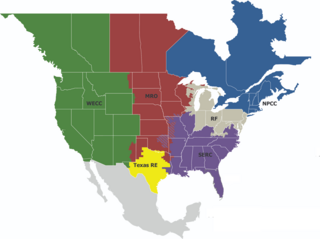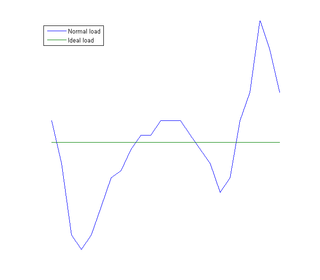Related Research Articles
In reliability engineering, the term availability has the following meanings:

The North American Electric Reliability Corporation (NERC) is a nonprofit corporation based in Atlanta, Georgia, and formed on March 28, 2006, as the successor to the North American Electric Reliability Council. The original NERC was formed on June 1, 1968, by the electric utility industry to promote the reliability and adequacy of bulk power transmission in the electric utility systems of North America. NERC's mission states that it is to "ensure the reliability of the North American bulk power system."

Southern California Edison, the largest subsidiary of Edison International, is the primary electricity supply company for much of Southern California. It provides 15 million people with electricity across a service territory of approximately 50,000 square miles. However, the Los Angeles Department of Water and Power, San Diego Gas & Electric (SDG&E), Imperial Irrigation District, and some smaller municipal utilities serve substantial portions of the southern California territory. The northern part of the state is generally served by the Pacific Gas & Electric Company of San Francisco. Other investor-owned utilities (IOUs) in California include SDG&E, PacifiCorp, Bear Valley Electric, and Liberty Utilities.
The Open Access Same-Time Information System (OASIS), is an Internet-based system for obtaining services related to electric power transmission in North America. It is the primary means by which high-voltage transmission lines are reserved for moving wholesale quantities of electricity. The OASIS concept was originally conceived with the Energy Policy Act of 1992, and formalized in 1996 through Federal Energy Regulatory Commission (FERC) Orders 888 and 889.

The Electric Reliability Council of Texas, Inc. (ERCOT) is an American organization that operates Texas's electrical grid, the Texas Interconnection, which supplies power to more than 25 million Texas customers and represents 90 percent of the state's electric load. ERCOT is the first independent system operator (ISO) in the United States. ERCOT works with the Texas Reliability Entity (TRE), one of eight regional entities within the North American Electric Reliability Corporation (NERC) that coordinate to improve reliability of the bulk power grid.

Arizona Public Service (APS) is the largest electric utility in Arizona, United States. Since 1985, it has been the principal subsidiary of publicly traded S&P 500 member Pinnacle West Capital Corporation, known as AZP Group until 1987. Pinnacle West Capital made a profit of $500 million in 2017.

A diesel generator (DG) (also known as a diesel Genset) is the combination of a diesel engine with an electric generator (often an alternator) to generate electrical energy. This is a specific case of engine generator. A diesel compression-ignition engine is usually designed to run on diesel fuel, but some types are adapted for other liquid fuels or natural gas.
The availability factor of a power plant is the amount of time that it is able to produce electricity over a certain period, divided by the amount of the time in the period. Occasions where only partial capacity is available may or may not be deducted. Where they are deducted, the metric is titled equivalent availability factor (EAF). The availability factor should not be confused with the capacity factor. The capacity factor for a given period can never exceed the availability factor for the same period. The difference arises when the plant is run at less than full capacity, in which case the capacity factor is less than the availability factor.
Power system protection is a branch of electrical power engineering that deals with the protection of electrical power systems from faults through the disconnection of faulted parts from the rest of the electrical network. The objective of a protection scheme is to keep the power system stable by isolating only the components that are under fault, whilst leaving as much of the network as possible in operation. The devices that are used to protect the power systems from faults are called protection devices.

The Texas Interconnection is an alternating current (AC) power grid – a wide area synchronous grid – that covers most of the state of Texas. The grid is managed by the Electric Reliability Council of Texas (ERCOT).
The term downtime is used to refer to periods when a system is unavailable.

An engine–generator is the combination of an electrical generator and an engine mounted together to form a single piece of equipment. This combination is also called an engine–generator set or a gen-set. In many contexts, the engine is taken for granted and the combined unit is simply called a generator. An engine–generator may be a fixed installation, part of a vehicle, or made small enough to be portable.

Load management, also known as demand-side management (DSM), is the process of balancing the supply of electricity on the network with the electrical load by adjusting or controlling the load rather than the power station output. This can be achieved by direct intervention of the utility in real time, by the use of frequency sensitive relays triggering the circuit breakers, by time clocks, or by using special tariffs to influence consumer behavior. Load management allows utilities to reduce demand for electricity during peak usage times, which can, in turn, reduce costs by eliminating the need for peaking power plants. In addition, some peaking power plants can take more than an hour to bring on-line which makes load management even more critical should a plant go off-line unexpectedly for example. Load management can also help reduce harmful emissions, since peaking plants or backup generators are often dirtier and less efficient than base load power plants. New load-management technologies are constantly under development — both by private industry and public entities.

Availability Based Tariff (ABT) is a frequency based pricing mechanism applicable in India for unscheduled electric power transactions. The ABT falls under electricity market mechanisms to charge and regulate power to achieve short term and long term network stability as well as incentives and dis-incentives to grid participants against deviations in committed supplies as the case may be.

An electrical grid is an interconnected network for electricity delivery from producers to consumers. Electrical grids vary in size and can cover whole countries or continents. It consists of:
In electrical engineering, forced outage is the shutdown condition of a power station, transmission line or distribution line when the generating unit is unavailable to produce power due to unexpected breakdown.

Idaho National Laboratory ran the Aurora Generator Test in 2007 to demonstrate how a cyberattack could destroy physical components of the electric grid. The experiment used a computer program to rapidly open and close a diesel generator's circuit breakers out of phase from the rest of the grid, thereby subjecting the engine to abnormal torques and ultimately causing it to explode. This vulnerability is referred to as the Aurora Vulnerability.
Reliability index is an attempt to quantitatively assess the reliability of a system using a single numerical value. The set of reliability indices varies depending on the field of engineering, multiple different indices may be used to characterize a single system. In the simple case of an object that cannot be used or repaired once it fails, a useful index is the mean time to failure representing an expectation of the object's service lifetime. Another cross-disciplinary index is forced outage rate (FOR), a probability that a particular type of a device is out of order. Reliability indices are extensively used in the modern electricity regulation.
Power system operations is a term used in electricity generation to describe the process of decision-making on the timescale from one day to minutes prior to the power delivery. The term power system control describes actions taken in response to unplanned disturbances in order to provide reliable electric supply of acceptable quality. The corresponding engineering branch is called Power System Operations and Control. Electricity is hard to store, so at any moment the supply (generation) shall be balanced with demand. In an electrical grid the task of real-time balancing is performed by a regional-based control center, run by an electric utility in the traditional electricity market. In the restructured North American power transmission grid, these centers belong to balancing authorities numbered 74 in 2016, the entities responsible for operations are also called independent system operators, transmission system operators. The other form of balancing resources of multiple power plants is a power pool. The balancing authorities are overseen by reliability coordinators.
References
- ↑ David John Smith (2005). Reliability, Maintainability and Risk. Butterworth-Heinemann. p. 42. ISBN 9780750666947.
- ↑ North American Electric Reliability Corporation's (NERC) Generating Availability Data System (GADS) Data Reporting Instructions (DRI).
- 1 2 Alexander Eydeland and Krzysztof Wolyniec (2003). Energy and Power Risk Management. John Wiley and Sons. p. 109. ISBN 9780471455875.